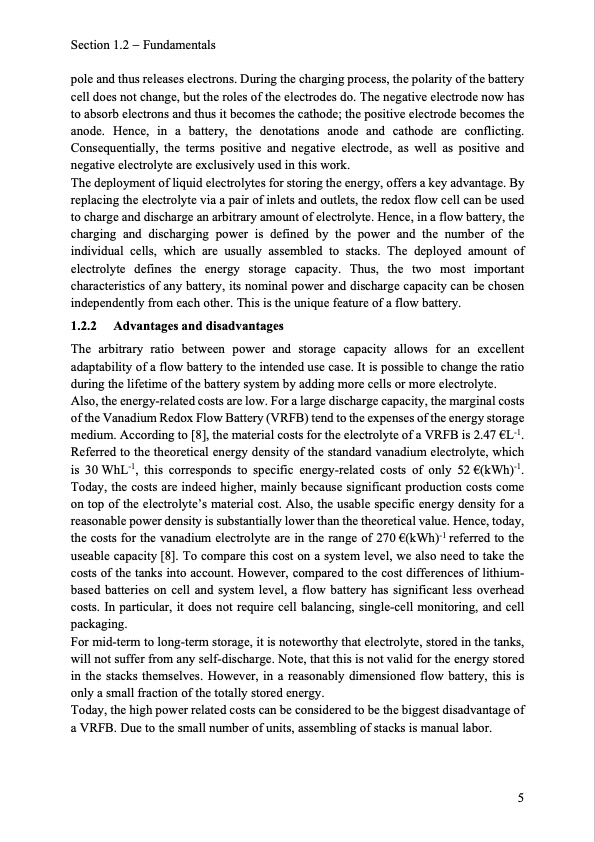
PDF Publication Title:
Text from PDF Page: 013
Section 1.2 Fundamentals pole and thus releases electrons. During the charging process, the polarity of the battery cell does not change, but the roles of the electrodes do. The negative electrode now has to absorb electrons and thus it becomes the cathode; the positive electrode becomes the anode. Hence, in a battery, the denotations anode and cathode are conflicting. Consequentially, the terms positive and negative electrode, as well as positive and negative electrolyte are exclusively used in this work. The deployment of liquid electrolytes for storing the energy, offers a key advantage. By replacing the electrolyte via a pair of inlets and outlets, the redox flow cell can be used to charge and discharge an arbitrary amount of electrolyte. Hence, in a flow battery, the charging and discharging power is defined by the power and the number of the individual cells, which are usually assembled to stacks. The deployed amount of electrolyte defines the energy storage capacity. Thus, the two most important characteristics of any battery, its nominal power and discharge capacity can be chosen independently from each other. This is the unique feature of a flow battery. 1.2.2 Advantages and disadvantages The arbitrary ratio between power and storage capacity allows for an excellent adaptability of a flow battery to the intended use case. It is possible to change the ratio during the lifetime of the battery system by adding more cells or more electrolyte. Also, the energy-related costs are low. For a large discharge capacity, the marginal costs of the Vanadium Redox Flow Battery (VRFB) tend to the expenses of the energy storage medium. According to [8], the material costs for the electrolyte of a VRFB is 2.47 €L-1. Referred to the theoretical energy density of the standard vanadium electrolyte, which is 30 WhL-1, this corresponds to specific energy-related costs of only 52 €(kWh)-1. Today, the costs are indeed higher, mainly because significant production costs come on top of the electrolyte’s material cost. Also, the usable specific energy density for a reasonable power density is substantially lower than the theoretical value. Hence, today, the costs for the vanadium electrolyte are in the range of 270 €(kWh)-1 referred to the useable capacity [8]. To compare this cost on a system level, we also need to take the costs of the tanks into account. However, compared to the cost differences of lithium- based batteries on cell and system level, a flow battery has significant less overhead costs. In particular, it does not require cell balancing, single-cell monitoring, and cell packaging. For mid-term to long-term storage, it is noteworthy that electrolyte, stored in the tanks, will not suffer from any self-discharge. Note, that this is not valid for the energy stored in the stacks themselves. However, in a reasonably dimensioned flow battery, this is only a small fraction of the totally stored energy. Today, the high power related costs can be considered to be the biggest disadvantage of a VRFB. Due to the small number of units, assembling of stacks is manual labor. 5PDF Image | Model-based Design Vanadium Redox Flow Batteries

PDF Search Title:
Model-based Design Vanadium Redox Flow BatteriesOriginal File Name Searched:
10-5445IR1000070670.pdfDIY PDF Search: Google It | Yahoo | Bing
Salgenx Redox Flow Battery Technology: Salt water flow battery technology with low cost and great energy density that can be used for power storage and thermal storage. Let us de-risk your production using our license. Our aqueous flow battery is less cost than Tesla Megapack and available faster. Redox flow battery. No membrane needed like with Vanadium, or Bromine. Salgenx flow battery
| CONTACT TEL: 608-238-6001 Email: greg@salgenx.com | RSS | AMP |